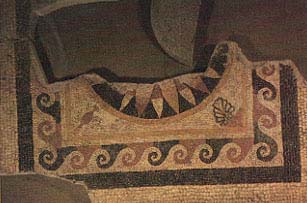Image Details

Courtesy Israel Antiquities Authority/Israel Museum/David Harris
Cut stone cubes, or tesserae, began to replace pebbles in mosaics in the second century B.C.E., giving artists more control over their colors and designs, and spurring the widespread popularity of mosaics. Typical of such decorative mosaics is this one from the vestibule of a bathing complex in Jerusalem’s ancient Upper City, excavated by Nahman Avigad. A square frame and “wave-crest” pattern enclose a largely destroyed rosette with many petals. A palmette appears in the lower right corner between the circle and the frame. The spindle bottle in the lower left corner was a common type in the Hellenistic period, but it went out of use early in the first century C.E., thus dating the mosaic to before that time.
